●●● physical properties in the PAULING FILE
●● features
The Physical Properties section of the PAULING FILE collects experimental and calculated data for a broad range of intrinsic physical properties (see below) of inorganic compounds in the solid (crystalline) state. When relevant, the entries also contain information about synthesis and sample preparation, as well as information that helps to establish the links to Phase Diagram and Crystal Structure entries, such as colloquial names, crystallographic data, limits of stability with respect to temperature, pressure or composition. Processing is literature-oriented and each database entry groups selected data extracted for a particular phase in a particular publication. Focus is on the characterization of inorganic substances (single-phase samples), rather than on the optimization of materials.
The properties are stored in four different ways:
● numerical data and experimental details defining their determination
● description of figures (Y vs. X)
● property classes such as superconductor, ferroelectric, etc.
● keywords indicating the existence of particular data, e.g. spectra
Symbols recommended by the Handbook of Chemistry and Physics [1] are used throughout the database; numerical values are given in as-published units and SI units.
● concept
Storage of properties and conditions for their determination. Green fields belong to reference tables, thanks to which symbols, units, unit conversion, and ranges of magnitude can be controlled.
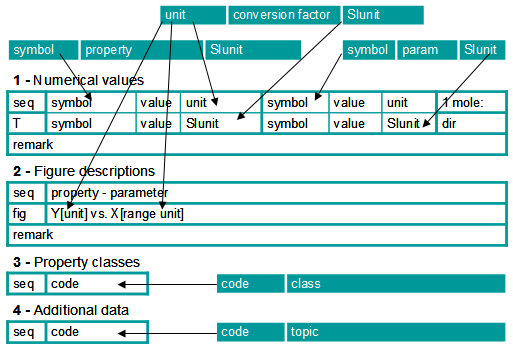
●● data selection
Data are taken from primary literature. Each database entry corresponds to one combination inorganic phase - publication, but can contain several numerical values, figure descriptions, and references to additional data. For an investigation of a compound through a temperature- or pressure-induced structural phase transition there will be two database entries, e.g. one for the rt modification and one for the lt modification. When no information is provided in the paper, ferroelectric transitions are by default considered to be accompanied by structural changes, magnetic, electric or superconducting transitions not. For a complete solid solution between two binary compounds, three database entries will be created: one for each binary border compound and one for the ternary system.
An indicative list of properties selected for the PAULING FILE is given below.
●●● statistics
●● distribution according to journal
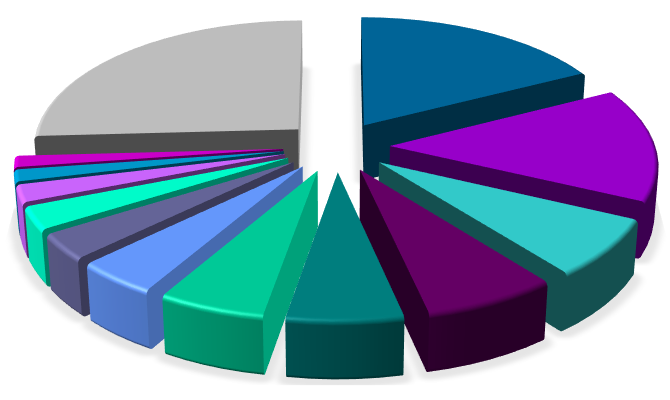
|

|
● journals
Physical Review B Journal of Alloys and Compounds Solid State Communications Physica B+C Journal of Magnetism and Magnetic Materials Journal of Solid State Chemistry Journal of Physics: Condensed Matter Journal of the Physical Society of Japan Journal of Applied Physics Physica Status Solidi A Physical Review Letters Materials Research Bulletin others 71'113 publications processed 01.01.2023 |
●● distribution according to publication year
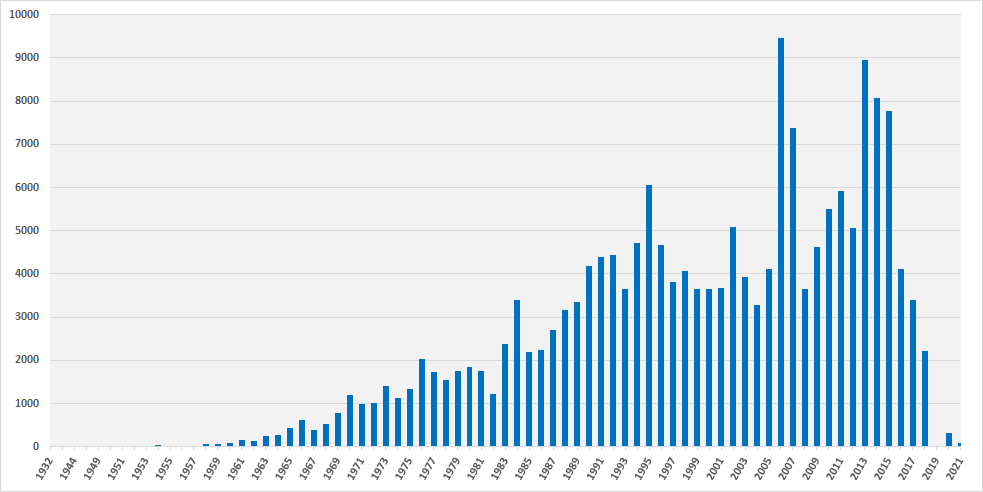
●● distribution according to chemical class
| ● 1 or 2 elements | ● 3 elements | ● 4 or more elements |
|
 56'565 |
 65'643 |
 70'267 |
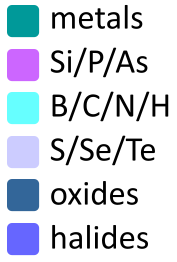
|
●● distribution according to property class
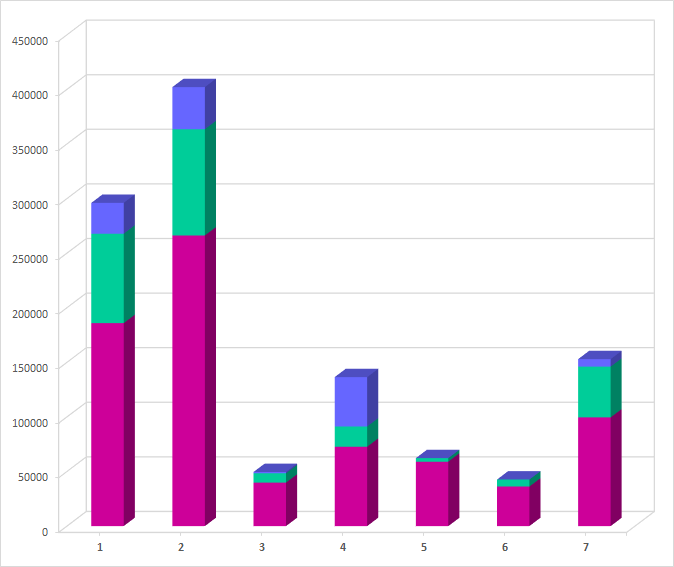
|
● property class
1 electronic and electrical properties 2 magnetic properties 3 mechanical properties 4 optical properties 5 phase transitions 6 superconductor properties 7 thermal and thermodynamic properties ● data category from bottom to top: - numerical values - figure descriptions - additional data |
●●● list of properties
Below are listed the main properties considered in the PAULING FILE, grouped into categories. Items in square brackets are keywords, for which numerical values are in principle not extracted. Primary properties, to which particular importance is paid for the storage of numerical values, are emphasized with bold characters.
metal/nonmetal character
temperature for metal-nonmetal transition
electron energy band structure
pressure derivative of temperature for metal-nonmetal transition
pressure for metal-nonmetal transition
[ electron energy band structure ]
[ Brillouin zone ]
[ Fermi energy ]
[ Fermi surface ]
electron density of states
[ Brillouin zone ]
[ Fermi energy ]
[ Fermi surface ]
electron density of states at Fermi level
electron density of states at Fermi level per spin
[ electron density of states diagram ]
[ electron density maps ]
energy gap
electron density of states at Fermi level per spin
[ electron density of states diagram ]
[ electron density maps ]
energy gap
exciton energy
activation energy
pressure derivative of energy gap
temperature derivative of energy gap
composition derivative of energy gap
energy gap for direct transitiontemperature derivative of energy gap
composition derivative of energy gap
pressure derivative of energy gap for direct transition
temperature derivative of energy gap for direct transition
energy gap for indirect transitiontemperature derivative of energy gap for direct transition
pressure derivative of energy gap for indirect transition
temperature derivative of energy gap for indirect transition
thermal energy gaptemperature derivative of energy gap for indirect transition
exciton energy
pressure derivative of exciton energy
temperature derivative of exciton energy
temperature derivative of exciton energy
activation energy for impurity conduction
activation energy for migration of vacancies
electrical conductivity/resistivity
pressure derivative of activation energy for impurity conduction
activation energy for electronic contribution to conductivity activation energy for migration of vacancies
electrical resistivity
phonon resistivity
electron conductivity
hole conductivity
residual resistivity
temperature derivative of electrical resistivity
concentration derivative of electrical resistivity
electrical resistivity anisotropy concentration derivative of electrical resistivity
phonon resistivity
temperature derivative of phonon resistivity
magnetic resistivity
temperature derivative of magnetic resistivity
ionic conductivityelectron conductivity
hole conductivity
residual resistivity
residual resistivity ratio (RRR)
spin-disorder resistivity
residual resistivity ratio (RRR)
[ spin-disorder resistivity data ]
spin-fluctuation resistivity
[ spin-fluctuation resistivity data ]
piezoresistivity
piezoresistivity
magnetoresistivity
pressure derivative of piezoresistivity
temperature derivative of piezoresistivity
magnetic contribution to piezoresistivity temperature derivative of piezoresistivity
magnetoresistivity
Hall coefficients
temperature derivative of magnetoresistivity
Hall coefficient
extraordinary Hall coefficient
effective mass
pressure derivative of Hall coefficient
temperature derivative of Hall coefficient
ordinary Hall coefficienttemperature derivative of Hall coefficient
extraordinary Hall coefficient
effective mass of electrons in conduction band
effective mass of electrons in conduction band anisotropy
effective mass of holes in valence band
effective mass of polarons
charge carrier concentration
effective mass of electrons in conduction band anisotropy
effective mass of holes in valence band
pressure derivative of effective mass of holes in valence band
effective mass of electrons/holes ratio effective mass of polarons
electron concentration
hole concentration
electron/hole concentration ratio
charge carrier concentration
donor concentration
acceptor concentration
donor/acceptor concentration ratio
effective electron number
intrinsic carrier concentration
charge carrier mobility
hole concentration
electron/hole concentration ratio
charge carrier concentration
donor concentration
acceptor concentration
donor/acceptor concentration ratio
effective electron number
intrinsic carrier concentration
electron mobility
Hall mobility
charge-density wave
pressure derivative of electron mobility
hole mobility
pressure derivative of hole mobility
electron/hole mobility ratio Hall mobility
pressure derivative of Hall mobility
ion mobility
[ charge-density wave energy gap ]
charge transfer
effective charge
mean valence
quadrupole splitting
mean valence
[ quadrupole splitting ]
electric-field gradient
[ electric-field gradient ]
ferroelectric transitions
ferroelectric Curie temperature
permittivity (dielectric constant)
pressure derivative of ferroelectric Curie temperature
antiferroelectric Néel temperature
pressure derivative of antiferroelectric Néel temperature
temperature for transition to different ferroelectric state
permittivity
imaginary part of permittivity
permittivity change at phase transition
static permittivity
electric polarization
pressure derivative of permittivity
temperature derivative of permittivity
real part of permittivity temperature derivative of permittivity
imaginary part of permittivity
permittivity change at phase transition
static permittivity
pressure derivative of static permittivity
temperature derivative of static permittivity
high-frequency permittivitytemperature derivative of static permittivity
pressure derivative of high-frequency permittivity
temperature derivative of high-frequency permittivity
dielectric loss tangent temperature derivative of high-frequency permittivity
electric polarization
spontaneous electric polarization
paraelectric state
spontaneous electric polarization
pressure derivative of spontaneous electric polarization
electric dipole moment
paraelectric Curie temperature
ferroelectric hysteresis
pressure derivative of paraelectric Curie temperature
paraelectric Curie coefficient
coercive electrical field
remanent polarization
ferroelectric phase diagram
remanent polarization
[ electrical field – composition diagram ]
[ electrical field – temperature diagram ]
piezoelectricity
[ electrical field – temperature diagram ]
[ piezoelectric coefficients ]
pyroelectricity
[ pyroelectric coefficients ]
magnetic transitions
Curie temperature
magnetic susceptibility
pressure derivative of Curie temperature
composition derivative of Curie temperature
Néel temperaturecomposition derivative of Curie temperature
pressure derivative of Néel temperature
composition derivative of Néel temperature
freezing temperature for spin glass composition derivative of Néel temperature
pressure derivative of freezing temperature for spin glass
temperature for transition to different magnetic order
pressure derivative of temperature for magnetic transition
pressure for magnetic transition
temperature derivative of pressure for magnetic transition
magnetic field for magnetic transition
pressure derivative of magnetic field for magnetic transition
magnetic susceptibility
imaginary part of magnetic susceptibility
temperature-independent part of magnetic susceptibility
Langevin contribution to magnetic susceptibility
Pauli magnetic susceptibility
Van Vleck contribution to magnetic susceptibility
diamagnetic contribution to magnetic susceptibility
core-electron contribution to magnetic susceptibility
valence-electron contribution to magnetic susceptibility
orbital contribution to magnetic susceptibility
spin contribution to magnetic susceptibility
paramagnetic contribution to magnetic susceptibility
magnetic permeability
real part of magnetic permeability
imaginary part of magnetic permeability
Stoner enhancement factor
Stoner parameter
Stoner product
magnetization
pressure derivative of magnetic susceptibility
temperature derivative of magnetic susceptibility
real part of magnetic susceptibility temperature derivative of magnetic susceptibility
imaginary part of magnetic susceptibility
temperature-independent part of magnetic susceptibility
Langevin contribution to magnetic susceptibility
Pauli magnetic susceptibility
Van Vleck contribution to magnetic susceptibility
diamagnetic contribution to magnetic susceptibility
core-electron contribution to magnetic susceptibility
valence-electron contribution to magnetic susceptibility
orbital contribution to magnetic susceptibility
spin contribution to magnetic susceptibility
paramagnetic contribution to magnetic susceptibility
magnetic permeability
real part of magnetic permeability
imaginary part of magnetic permeability
Stoner enhancement factor
Stoner parameter
Stoner product
magnetization
saturation magnetization
spontaneous magnetization
orbital magnetic moment
spin magnetic moment
saturation magnetic moment
paramagnetic state
saturation magnetization
spontaneous magnetization
pressure derivative of spontaneous magnetization
magnetic momentorbital magnetic moment
spin magnetic moment
saturation magnetic moment
pressure derivative of saturation magnetic moment
spontaneous magnetic moment
pressure derivative of spontaneous magnetic moment
paramagnetic moment (effective Bohr magneton number)
molecular field
molecular field parameter
magnetic hysteresis
pressure derivative of paramagnetic moment
paramagnetic Curie temperature
pressure derivative of paramagnetic Curie temperature
Curie coefficient molecular field
molecular field parameter
coercive field
remanent induction
maximum energy product
magnetic phase diagram
remanent induction
maximum energy product
[ magnetic field – composition diagram ]
[ magnetic field – temperature diagram ]
magnetic structure
[ magnetic field – temperature diagram ]
[ magnetic structure ]
[ easy direction of magnetization ]
magnetic anisotropy
[ easy direction of magnetization ]
magnetic anisotropy field
magnetic anisotropy energy
first-order magnetocrystalline anisotropy coefficient
second-order magnetocrystalline anisotropy coefficient
third-order magnetocrystalline anisotropy coefficient
fourth-order magnetocrystalline anisotropy coefficient
sixth-order magnetocrystalline anisotropy coefficient
crystal electric field
magnetic anisotropy energy
first-order magnetocrystalline anisotropy coefficient
second-order magnetocrystalline anisotropy coefficient
third-order magnetocrystalline anisotropy coefficient
fourth-order magnetocrystalline anisotropy coefficient
sixth-order magnetocrystalline anisotropy coefficient
crystal electric field levels
crystal electric field parameters
crystal electric field splitting
nuclear moment
crystal electric field parameters
crystal electric field splitting
nuclear moment
isomer shift
[ isomer shift ]
hyperfine magnetic field
[ hyperfine magnetic fields at nuclei ]
exchange field
[ exchange field ]
[ exchange interaction parameters ]
magneto-electric effect
[ exchange interaction parameters ]
[ magneto-electric effect ]
[ magnon density of states ]
Kondo behavior
[ magnon density of states ]
[ Kondo behavior ]
Kondo temperature
spin-fluctuation
Kondo temperature
pressure derivative of Kondo temperature
spin-fluctuation temperature
resonance spectroscopy
[ Mössbauer spectra ]
[ antiferromagnetic resonance spectroscopy AFMR ]
[ cyclotron resonance spectra ]
[ electrically detected magnetic resonance spectroscopy EDMR ]
[ electron nuclear double resonance spectroscopy ENDOR ]
[ electron paramagnetic resonance spectroscopy EPR ]
[ electron spin resonance spectroscopy ESR ]
[ ferrimagnetic resonance spectroscopy FiMR ]
[ ferromagnetic resonance spectroscopy FMR ]
[ magnetic Compton scattering MCS ]
[ muon spin rotation spectroscopy µSR ]
[ nuclear magnetic resonance spectroscopy NMR ]
[ nuclear quadrupolar resonance spectroscopy NQR ]
[ optically detected magnetic resonance spectroscopy ODMR ]
[ positron annihilation spectroscopy PAS ]
de Haas - van Alphen effect
[ antiferromagnetic resonance spectroscopy AFMR ]
[ cyclotron resonance spectra ]
[ electrically detected magnetic resonance spectroscopy EDMR ]
[ electron nuclear double resonance spectroscopy ENDOR ]
[ electron paramagnetic resonance spectroscopy EPR ]
[ electron spin resonance spectroscopy ESR ]
[ ferrimagnetic resonance spectroscopy FiMR ]
[ ferromagnetic resonance spectroscopy FMR ]
[ magnetic Compton scattering MCS ]
[ muon spin rotation spectroscopy µSR ]
[ nuclear magnetic resonance spectroscopy NMR ]
[ nuclear quadrupolar resonance spectroscopy NQR ]
[ optically detected magnetic resonance spectroscopy ODMR ]
[ positron annihilation spectroscopy PAS ]
[ de Haas - van Alphen effect ]
Shubnikov - de Haas effect
[ Shubnikov - de Haas effect ]
hardness
microhardness
Vickers hardness
Mohs hardness number
Knoop hardness number
elastic coefficients
Vickers hardness
Mohs hardness number
Knoop hardness number
elastic stiffness coefficient
elastic compliance coefficient
compressibility
pressure derivative of elastic stiffness coefficient
temperature derivative of elastic stiffness coefficient
[ higher-order elastic coefficients ]temperature derivative of elastic stiffness coefficient
elastic compliance coefficient
temperature derivative of elastic compliance
adiabatic linear compressibility
isothermal linear compressibility
isothermal volume compressibility
for cell parameters vs. pressure see PAULING FILE – Crystal Structures
volume change at phase transition
isothermal linear compressibility
temperature derivative of isothermal linear compressibility
adiabatic volume compressibilityisothermal volume compressibility
for cell parameters vs. pressure see PAULING FILE – Crystal Structures
relative volume change at pressure-induced phase transition
elastic moduli
adiabatic bulk modulus
Young's modulus
shear modulus
Grüneisen coefficients
pressure derivative of adiabatic bulk modulus
temperature derivative of adiabatic bulk modulus
isothermal bulk modulustemperature derivative of adiabatic bulk modulus
pressure derivative of isothermal bulk modulus
temperature derivative of isothermal bulk modulus
bulk/shear modulus ratiotemperature derivative of isothermal bulk modulus
Young's modulus
shear modulus
temperature derivative of shear modulus
Poisson ratio
pressure derivative of Poisson ratio
temperature derivative of Poisson ratio
temperature derivative of Poisson ratio
electronic Grüneisen coefficient
phonon Grüneisen coefficient
ferroelasticity
phonon Grüneisen coefficient
spontaneous elastic strain
magnetostriction
linear magnetostriction
spontaneous linear magnetostriction
volume magnetostriction
spontaneous volume magnetostriction
sound velocity
magnetic field derivative of linear magnetostriction
saturation linear magnetostrictionspontaneous linear magnetostriction
volume magnetostriction
magnetic field derivative of volume magnetostriction
saturation volume magnetostriction spontaneous volume magnetostriction
sound velocity
pressure derivative of sound velocity
temperature derivative of sound velocity
temperature derivative of sound velocity
optical absorption
optical absorption coefficient
reflectivity
temperature derivative of optical absorption coefficient
transmittance
reflectivity
optical conductivity
photon energy derivative of reflectivity
optical conductivity
real part of optical conductivity
imaginary part of optical conductivity
refractive index
real part of optical conductivity
imaginary part of optical conductivity
refractive index
birefringence
permittivity (dielectric constant)
pressure derivative of refractive index
temperature derivative of refractive index
wavelength derivative of refractive index
high-frequency refractive index temperature derivative of refractive index
wavelength derivative of refractive index
birefringence
temperature derivative of birefringence
circular birefringence
permittivity
imaginary part of permittivity
real/imaginary part of permittivity ratio
static permittivity
optical phonons
pressure derivative of permittivity
temperature derivative of permittivity
real part of permittivity temperature derivative of permittivity
imaginary part of permittivity
real/imaginary part of permittivity ratio
static permittivity
pressure derivative of static permittivity
temperature derivative of static permittivity
high-frequency permittivitytemperature derivative of static permittivity
pressure derivative of high-frequency permittivity
temperature derivative of high-frequency permittivity
static/high-frequency permittivity ratiotemperature derivative of high-frequency permittivity
energy of optical phonon
energy of longitudinal optical phonon
energy of transverse optical phonon
wavenumber of longitudinal optical phonon
wavenumber of transverse optical phonon
[ phonon density of states ]
[ phonon dispersion ]
plasma edge
energy of longitudinal optical phonon
energy of transverse optical phonon
wavenumber of longitudinal optical phonon
wavenumber of transverse optical phonon
[ phonon density of states ]
[ phonon dispersion ]
plasma edge
plasma frequency
plasma wavelength
photo-conductivity
plasma frequency
plasma wavelength
[ photo-conductivity data ]
non-linear optics
[ non-linear optics ]
work function
work function
luminescence
[ luminescence ]
magneto-optical effects
[ magneto-optical Kerr effect ]
[ magneto-optical Faraday effect ]
magnetic dichroism
[ magneto-optical Faraday effect ]
[ magnetic circular X-ray dichroism ]
[ magnetic circular dichroism ]
[ magnetic circular dichroism of absorption ]
[ linear dichroism ]
vibrational spectroscopy
[ magnetic circular dichroism ]
[ magnetic circular dichroism of absorption ]
[ linear dichroism ]
[ Brillouin scattering ]
[ Raman scattering ]
[ infrared spectroscopy ]
optical spectroscopy
[ Raman scattering ]
[ infrared spectroscopy ]
[ Bremsstrahlung isochromat spectroscopy BIS ]
[ X-ray absorption near-edge spectroscopy XANES ]
[ X-ray absorption spectroscopy XAS ]
[ X-ray photoemission spectroscopy XPS ]
[ angle-resolved X-ray photoemission spectroscopy ARXPS ]
[ angle-resolved photoelectron spectroscopy ARPES ]
[ angle-resolved ultraviolet photoemission spectroscopy ARUPS ]
[ electron energy loss spectroscopy EELS ]
[ extended X-ray absorption fine structure EXAFS ]
[ inelastic X-ray scattering IXS ]
[ inverse photoemission spectroscopy IPS ]
[ neutron energy loss spectroscopy NELS ]
[ perturbed angular correlation PAC ]
[ photoelectron emission spectroscopy PES ]
[ soft-X-ray emission spectroscopy SXES ]
[ ultraviolet photoemission spectroscopy UPS ]
[ X-ray absorption near-edge spectroscopy XANES ]
[ X-ray absorption spectroscopy XAS ]
[ X-ray photoemission spectroscopy XPS ]
[ angle-resolved X-ray photoemission spectroscopy ARXPS ]
[ angle-resolved photoelectron spectroscopy ARPES ]
[ angle-resolved ultraviolet photoemission spectroscopy ARUPS ]
[ electron energy loss spectroscopy EELS ]
[ extended X-ray absorption fine structure EXAFS ]
[ inelastic X-ray scattering IXS ]
[ inverse photoemission spectroscopy IPS ]
[ neutron energy loss spectroscopy NELS ]
[ perturbed angular correlation PAC ]
[ photoelectron emission spectroscopy PES ]
[ soft-X-ray emission spectroscopy SXES ]
[ ultraviolet photoemission spectroscopy UPS ]
fusion
temperature for congruent melting
peritectic formation
pressure derivative of melting temperature
melting pressure
temperature for peritectic formation
peritectoid formation
temperature for peritectoid formation
eutectoid formation
temperature for eutectoid formation
structural phase transitions
temperature for structural phase transition
magnetic field for structural phase transition
phase diagram
pressure derivative of transition temperature
composition derivative of transition temperature
pressure for structural phase transition composition derivative of transition temperature
magnetic field for structural phase transition
[ pressure - temperature phase diagram ]
for temperature - composition phase diagrams see PAULING FILE – Phase Diagrams
for temperature - composition phase diagrams see PAULING FILE – Phase Diagrams
superconducting transition temperature
superconducting transition temperature
critical magnetic field
pressure derivative of superconducting transition temperature
concentration derivative of superconducting transition temperature
lowest temperature for normal conductivity investigated concentration derivative of superconducting transition temperature
critical magnetic field for type I superconductor
irreversibility field
critical current density
pressure derivative of critical magnetic field
temperature derivative of critical magnetic field
lower critical magnetic field for type II superconductortemperature derivative of critical magnetic field
pressure derivative of lower critical magnetic field
temperature derivative of lower critical magnetic field
upper critical magnetic field for type II superconductortemperature derivative of lower critical magnetic field
pressure derivative of upper critical magnetic field
temperature derivative of upper critical magnetic field
upper critical magnetic field anisotropy temperature derivative of upper critical magnetic field
irreversibility field
critical current density
coherence length
coherence length
magnetic penetration depth
(London) magnetic penetration depth
Ginzburg-Landau parameter
electron-phonon interaction
Ginzburg-Landau parameter
electron-phonon interaction parameter
energy gap
energy gap for superconductivity
thermal expansion
linear thermal expansion coefficient
magnetic contribution to linear thermal expansion coefficient
volume thermal expansion coefficient
volume change at phase transition
pressure derivative of linear thermal expansion coefficient
temperature derivative of linear thermal expansion coefficient
for cell parameters vs. temperature see PAULING FILE – Crystal Structurestemperature derivative of linear thermal expansion coefficient
magnetic contribution to linear thermal expansion coefficient
volume thermal expansion coefficient
pressure derivative of volume thermal expansion coefficient
temperature derivative of volume thermal expansion coefficient
temperature derivative of volume thermal expansion coefficient
relative volume change at melting
relative volume change at structural phase transition
relative volume change at Curie point
relative volume change at Néel point
enthalpy/energy
relative volume change at structural phase transition
relative volume change at Curie point
relative volume change at Néel point
enthalpy of formation
enthalpy of reaction
Gibbs energy of formation
Gibbs energy of reaction
Helmholtz energy of formation
Helmholtz energy of reaction
[ cohesive energy ]
[ total energy calculation data ]
enthalpy/energy change at phase transition
enthalpy of reaction
Gibbs energy of formation
Gibbs energy of reaction
Helmholtz energy of formation
Helmholtz energy of reaction
[ cohesive energy ]
[ total energy calculation data ]
enthalpy of fusion
enthalpy change at eutectoid decomposition
enthalpy change at peritectoid decomposition
enthalpy of sublimation
enthalpy change at structural phase transition
heat capacity (specific heat)
enthalpy change at eutectoid decomposition
enthalpy change at peritectoid decomposition
enthalpy of sublimation
enthalpy change at structural phase transition
heat capacity at constant pressure
heat capacity at constant volume
phonon heat capacity at constant pressure
phonon heat capacity at constant volume
electronic contribution to heat capacity
superconducting heat capacity
electronic contribution to superconducting heat capacity
magnetic heat capacity
Schottky heat capacity
hyperfine heat capacity
heat capacity discontinuity
heat capacity at constant volume
phonon heat capacity at constant pressure
phonon heat capacity at constant volume
electronic contribution to heat capacity
superconducting heat capacity
electronic contribution to superconducting heat capacity
magnetic heat capacity
Schottky heat capacity
hyperfine heat capacity
heat capacity discontinuity at melting
heat capacity discontinuity at structural phase transition
heat capacity discontinuity at superconducting transition
heat capacity coefficients
heat capacity discontinuity at structural phase transition
heat capacity discontinuity at superconducting transition
electronic heat capacity coefficient
coefficient of Schottky term in heat capacity
coefficient of third-order term in heat capacity
coefficient of fifth-order term in heat capacity
coefficient of spin fluctuation term in heat capacity
Debye/Einstein temperature
coefficient of Schottky term in heat capacity
coefficient of third-order term in heat capacity
coefficient of fifth-order term in heat capacity
coefficient of spin fluctuation term in heat capacity
Debye temperature
Einstein temperature
entropy
Einstein temperature
entropy
entropy of formation
magnetic entropy
entropy change at phase transition
entropy of formation
magnetic entropy
entropy change at structural phase transition
entropy change at melting
sublimation entropy
thermoelectric power
entropy change at melting
sublimation entropy
thermoelectric power (Seebeck coefficient)
temperature derivative of thermoelectric power
thermoelectric figure of merit
thermal conductivity
temperature derivative of thermoelectric power
thermoelectric figure of merit
thermal conductivity
phonon contribution to thermal conductivity
Lorentz number
diffusion
pressure derivative of thermal conductivity
temperature derivative of thermal conductivity
electronic contribution to thermal conductivity temperature derivative of thermal conductivity
phonon contribution to thermal conductivity
Lorentz number
[ hydrogen diffusion ]
[ diffusion ]
[ diffusion ]
references
[1] Handbook of Chemistry and Physics, 78th edition, Eds. D.R. Lide, H.P.R. Frederikse, Boca Raton: CRC Press, 1997 and more recent editions.

